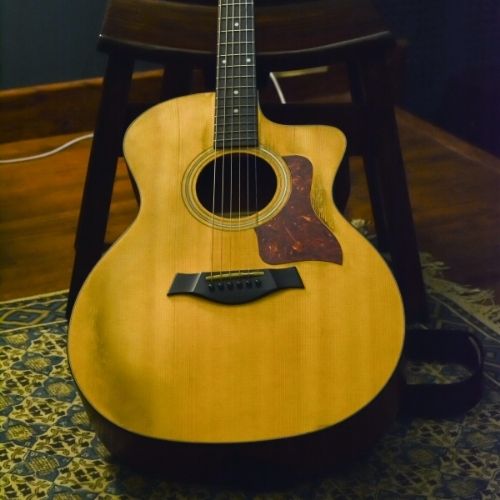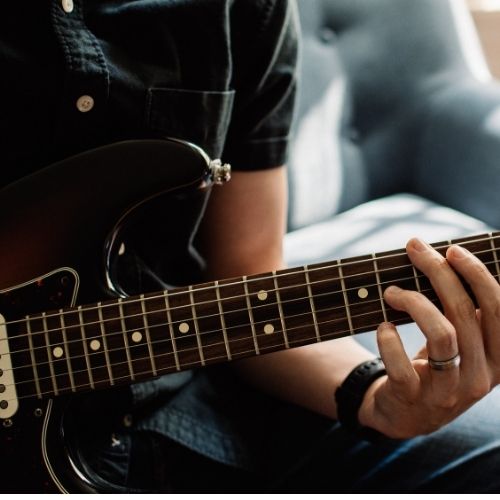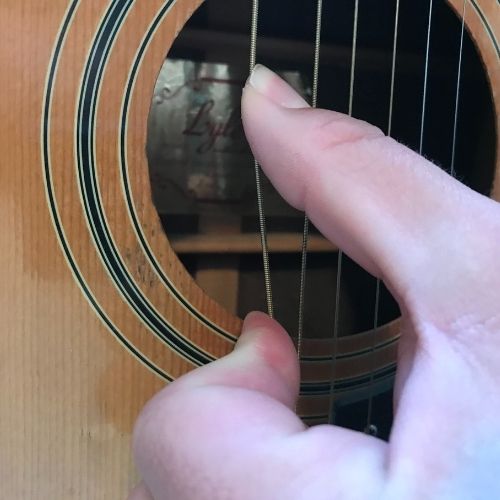We may get commissions for purchases made through links in this post. Thanks for the support! 👍
Whether you are a beginner, an expert, or even someone that has never touched a guitar, you likely have noticed a pick guard on guitars. You may not have thought about it, or even considered what it does, but you have seen it.
So why do guitars have pick guards? The plastic or wood pick guard you see on guitars is primarily to keep picks, rings, or anything else from damaging the wood on the face of a guitar while it is being played. Having this additional layer between those hard items and the soft wood of the guitar makes a guitar last considerably longer.
Let’s dig a little bit more into this reason, and a few others!

1. Avoid damage to guitar
As we already mentioned, avoiding scratches to the face of a guitar is important! The pickguard is the first line of defense here.
You find pick guards primarily on acoustic guitars, because these guitars are more likely to be strummed, and strumming a guitar’s strings leads to you running your pick along the body of the guitar.
When a pick guard is present, it lightly scratches that surface, instead of scratching the face of the guitar, which is not really replaceable.
This leads me to my next point!
2. Easily replaceable
If there is something that is likely to be damaged, you want it to be easily replaceable. Refinishing the face of a guitar is incredibly difficult, and replacing it is even more so.
However replacing a pick guard on a guitar is considerably easier, and much more cost effective. On higher end guitars you will find that they can be swapped out in minutes.
3. Styling
Finally, the last reason pick guards exist are for styling. Like many other industries, people like to customize, and make their guitars unique.
Pickguards are a quick, and easy way to set yourself apart from others!
With so many different designs out there today for guitars, you can make your guitar your own, and make you, and your style easily recognizable.
You can actually find plenty of great price options right here!
Why wouldn’t you want a pick guard?
Pick guards aren’t for everyone either! The main reason someone wouldn’t want a pick guard is for the aesthetics. Pick guards are generally plastic (as we have found), and some people would never want to have something plastic on the face of their guitar.
It also tends to break up the look of a guitar, leading some people to go without a pick guard. The other reason you may not want a pick guard is because it can affect the tone of the guitar, but we’ll talk more about that in the next section.
- Should you buy a used guitar? [Pros & Cons + Where to buy]
- Here’s Why You Can Teach Yourself Guitar
- This is why guitar hangers are safe, and you should get one!

Does pick guard affect sound?
While this is something most people playing guitar will likely ever notice, a pick guard can affect the sound of a guitar, ever so slightly.
The natural tone of a guitar comes from the wood, and having a potion of the face covered by plastic can make a guitar lose some of that natural tone.
Like I said though, most people will never notice, however people who have been playing long enough can tell the difference. I haven’t been playing long enough.
How are pick guards attached?
There are three different ways that pick guards can be attached to a guitar. The first way is by gluing the pick guard to the face of the guitar. This is obviously the cheapest way to do it, and makes it difficult to swap out the pick guard later down the road.
You generally will find this method on lower end guitars. Alternatively, the second way to attach a pick guard is by screws. This is generally used in medium, to high end guitars and is my favorite method. It allows you to quickly switch out pick guards whenever you want.
The last way to attach a pick guard is by a bracket. You will find this on electric guitars that have curbed bodies. This generally doesn’t allow for quite as easy of customization, as you have to buy another pick guard with the same mounting points.
Can you remove a pick guard from a guitar that is built with one?
This is one downside to buying a guitar that already has a pick guard, expecting to remove it. Most guitars that come with pick guards already installed, have it done with screws. The holes in the guitar for those holes will be rather obvious if the guard is removed.
Because of this, while you technically can remove a pick guard for good, it isn’t something you should count on, and still have a guitar that looks alright.
Frequently asked questions
What are pick guards made of?
Pick guards that most people will be familiar with are made of plastic. This is a cheap, and easy way to make pick guards. While less common, you can also find pick guards made of wood, and other materials. This post here at pickguards.com has a huge list of different designs and materials You can even find people making custom pick guards from license plates.
Should I remove plastic from pick guard?
So you just bought a guitar, and there is a plastic cover over top of your plastic pick guard. Should you remove it? Yes, yes you should remove it. That is only there to protect it until its final owner purchases it. Plus, it’s a lot of fun, kinda like removing that plastic covering from the microwave you just bought.
Can you put a pick guard on a guitar that doesn’t have one?
It actually is very easy to install a pick guard on a guitar the doesn’t have one currently! Thankfully many different pick guards are installed via a double sided tape, making it easy to do it yourself at home. However keep in mind, they are difficult to remove, so make sure you are making the right choice before doing so.
Conclusion
Regardless of if you have a pickguard, want a pickguard, or don’t want a pickguard you likely have at least acknowledged their existence.
They are here to help save our guitars from the certain damage of strumming away on one of our favorite past times, always looking out for us.

